By "generate", I mean auto-generation of the code necessary for a particular selected (set of) variable(s).
But any more explicit explication or comment on good practice is welcome.
By "generate", I mean auto-generation of the code necessary for a particular selected (set of) variable(s).
But any more explicit explication or comment on good practice is welcome.
Rather than using Ctrl + K, X you can also just type prop and then hit Tab twice.
Visual Studio also has a feature that will generate a Property from a private variable.
If you right-click on a variable, in the context menu that pops up, click on the "Refactor" item, and then choose Encapsulate Field.... This will create a getter/setter property for a variable.
I'm not too big a fan of this technique as it is a little bit awkward to use if you have to create a lot of getters/setters, and it puts the property directly below the private field, which bugs me, because I usually have all of my private fields grouped together, and this Visual Studio feature breaks my class' formatting.
I use Visual Studio 2013 Professional.




You also place the cursor for choosing a property. Use menu Edit → Refactor → Encapsulate Field...
Other information:
Since C# 3.0 (November 19th 2007), we can use auto-implemented properties (this is merely syntactic sugar).
And
private int productID;
public int ProductID
{
get { return productID; }
set { productID = value; }
}
becomes
public int ProductID { get; set; }
You can also use "propfull" and hit TAB twice.
The variable and property with get and set will be generated.
By generate, do you mean auto-generate? If that's not what you mean:
Visual Studio 2008 has the easiest implementation for this:
public PropertyType PropertyName { get; set; }
In the background this creates an implied instance variable to which your property is stored and retrieved.
However if you want to put in more logic in your Properties, you will have to have an instance variable for it:
private PropertyType _property;
public PropertyType PropertyName
{
get
{
//logic here
return _property;
}
set
{
//logic here
_property = value;
}
}
Previous versions of Visual Studio always used this longhand method as well.
As of visual studio 2019, select your properties like this:
Then press Ctrl+r
Then press Ctrl+e
A dialog will appear showing you the preview of the changes that are going to happen to your code. If everything looks good (which it mostly will), press OK.
If you are using Visual Studio 2005 and up, you can create a setter/getter real fast using the insert snippet command.
Right click on your code, click on Insert Snippet (Ctrl+K,X), and then choose "prop" from the list.
If you're using ReSharper, go into the ReSharper menu → Code → Generate...
(Or hit Alt + Ins inside the surrounding class), and you'll get all the options for generating getters and/or setters you can think of :-)
I created my own snippet that only adds {get; set;}. I made it just because I find prop → Tab to be clunky.
<?xml version="1.0" encoding="utf-8"?>
<CodeSnippets
xmlns="http://schemas.microsoft.com/VisualStudio/2005/CodeSnippet">
<CodeSnippet Format="1.0.0">
<Header>
<Title>get set</Title>
<Shortcut>get</Shortcut>
</Header>
<Snippet>
<Code Language="CSharp">
<![CDATA[{get; set;}]]>
</Code>
</Snippet>
</CodeSnippet>
</CodeSnippets>
With this, you type your PropType and PropName manually, then type get → Tab, and it will add the get set. It's nothing magical, but since I tend to type my access modifier first anyway, I may as well finish out the name and type.
In Visual Studio Community Edition 2015 you can select all the fields you want and then press Ctrl + . to automatically generate the properties.
You have to choose if you want to use the property instead of the field or not.
Use the propfull keyword.
It will generate a property and a variable.
Type keyword propfull in the editor, followed by two TABs. It will generate code like:
private data_type var_name;
public data_type var_name1{ get;set;}
Video demonstrating the use of snippet 'propfull' (among other things), at 4 min 11 secs.
In addition to the 'prop' snippet and auto-properties, there is a refactor option to let you select an existing field and expose it via a property (right click on the field → Refactor → Encapsulate Field...).
Also, if you don't like the 'prop' implementation, you can create your own snippets. Additionally, a third-party refactoring tool like ReSharper will give you even more features and make it easier to create more advanced snippets. I'd recommend ReSharper if you can afford it.
http://msdn.microsoft.com/en-us/library/f7d3wz0k(VS.80).aspx
Video demonstrating the use of snippet 'prop' (among other things), at 3 min 23 secs.
I don't have Visual Studio installed on my machine anymore (and I'm using Linux), but I do remember that there was an wizard hidden somewhere inside one of the menus that gave access to a class builder.
With this wizard, you could define all your classes' details, including methods and attributes. If I remember well, there was an option through which you could ask Visual Studio to create the setters and getters automatically for you.
I know it's quite vague, but check it out and you might find it.
On behalf of the Visual Studio tool, we can easily generate C# properties using an online tool called C# property generator.
First get Extension just press (Ctrl + Shift + X) and install getter setter ....
After this, just select your variable and right click. Go to Command palette...
And type getter ... It will suggest generate get and set methods. Click on this...
I personaly use CTRL+. and then select- "Encapsulated Fildes". That's a short for this option- (How can we generate getters and setters in Visual Studio?).